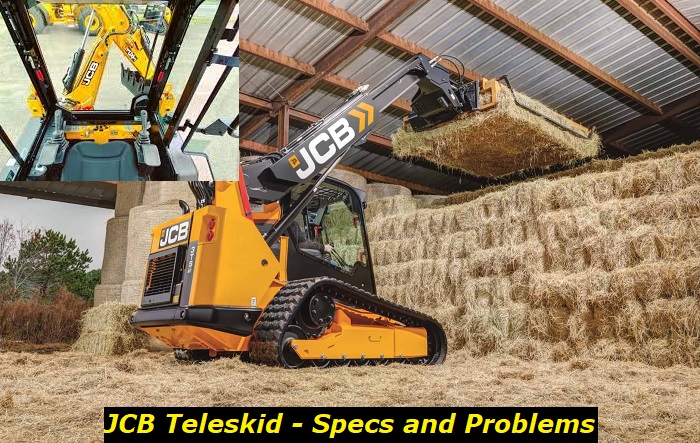JCB Teleskid Problems: Common Issues and Ways to Fix Them
While the JCB Teleskid is regarded as an excellent compact loader and skid steer, it can also run into its own set of problems, just like any other machine. This article will cover the common problems facing the JCB Teleskid and ways to fix them. But first, let's look at what JCB Teleskid is and its specifications.

What is a JCB Teleskid?
The JCB Teleskid is a skid steer loader that you can use on construction or landscaping projects. It's an incredibly sturdy and versatile machine since it is the first skid steer or compact tracked loader with a telescoping boom. The revolutionary telescopic technology allows operators to be able to load trucks without a ramp, reach over curbs, and dig below the ground.
It does all these with good attachment visibility. The JCB Teleskid can reach higher, further, and deeper than any other skid steers on the market, allowing you to access places you wouldn't have thought possible in a conventional skid steer.
JCB Teleskid Specifications
With a reach of 8 feet, a lift height of almost 13 feet, and an operational capacity of 3,695 lbs, the Teleskid is adaptable in any construction setting. This allows it to load vehicles without a ramp and easily and quickly reach over curbs. Other compact track loaders cannot dig below grade to a depth of 3 feet like the JCB Teleskid can. This can help to rip out trees and their roots.
Heavy objects can be placed on the ground without damaging it thanks to the 3,695 lbs. rated operating capacity of the JCB Teleskid when retracted and 1,600 lbs. when extended. When completely extended, you can operate the attachments with a hydraulic flow rate of 24 GPM. When the boom is fully retracted, optional 33 GPM high-flow couplers enable the safe operation of high-flow attachments.
Its all-in-one feature increases productivity by combining the functionality of 4 machines such as the compact wheel loader, forklift, compact track loader, and telescope handler. The optional dealer-installed flashing beacon and front screen guard offer safety to the operator. It also provides comfort and control with its fully adjustable air suspension seat and its electro-hydraulic controls, which are easy to use.
The personalized control area with a 7" touchscreen display located at the top right side of the cab provides the operator quick and easy access to change settings. It's also known for its strength due to its high-strength steel boom installed on a single-piece, completely welded chassis, and reliable components.
Common JCB Teleskid Problems
The JCB Teleskid has some common problems, including safety issues, mechanical issues, and corrosion of the skid steer components. Let's look at each of them.
Safety Issues
If not operated by qualified personnel, the skid steer loader is prone to different hazards. The hazards include entrapments, tipping over, runovers, hydraulic system failures, and collisions. These hazards can cause serious injuries and even lead to death. Let's look at some of the hazards.
- Entrapment
Entrapment happens when a person is trapped between the machine and another object or surface. This occurs when operators attempt to operate controls and levers while outside the skid-steer protective frame or when operators and assistants fail to communicate clearly. When the lifted arms or bucket suddenly moves, crushing injuries can result in broken and severed hands and feet.
- Tipping Over
Tipping over of the JCB Teleskid skid steer loader occurs when the light material bucket is improperly used. Modifying it to increase its volume capacity can make it extra heavy, especially when carrying a hefty load causing the steer loader to tip over. This can cause a fatal injury to the operator.
- Runovers
A runover happens when the compact loader goes over an operator who falls out of the machine while operating, bystanders, or personnel on the ground assisting the skid-steer operator. You can imagine how fatal this accident can be.
- Collisions
The skid steer loader may collide with other pieces of machinery, buildings, or workers due to poor visibility and faulty operation.
Mechanical issues
Mechanical issues affecting the JCB Teleskid include issues with the hydraulic system, control system, electrical system, and engine.
- Hydraulic System Issues
One of the most frequently encountered issues with skid steers is hydraulic system leaks. Too little or too much fluid in the hydraulic system might result in general system failure. Clogged fluid filters and failure of pumps and valves may also cause hydraulic problems. Other issues relating to the hydraulic system would be its ability to power the bucket, loader arm, and other attachments. Leaks in hydraulic hoses, fitting, or seals can lower loader performance and cause system pressure loss.
- A Problem with the Control System
One problem with the control system arises when the skid steer's steering and loader joystick controls stop responding to the operator's inputs. The control system may also have a problem if it responds but does so slowly. Bad circuits may compromise your control system causing it to fail.
- Engine Issues
Detonation, improper lubrication, and overheating are the three main reasons for engine failure. An engine overheating can result in catastrophic failure. The fuel system's filters, fuel tank, glow plugs, and the engine's throttle cable can be the main culprits of the failure.
- Electrical System Failure
On skid steers, a number of electrical components, such as switches, sensors, and control modules, may go bad, causing a failure of the electrical system. Loose or broken connections in the steering or loading can also cause this problem. An incorrectly linked joystick may also result in system failure. The electrical issues can cause the steer loader to stop working entirely or cause intermittent problems with the engine starting, gauges, or lights.
Corrosion of the Compact Loader Parts
Components such as hydraulic seals and hoses, attachments, tires, and tracks may corrode due to wear and tear caused by friction or even rust.
- Attachments
You can use JCB Teleskid with attachments such as forks, buckets, or grapples. All these components wear out with time due to friction, exposure to different weather conditions, and heavy loads.
- Hydraulic Seals and Hoses
The hydraulic seals and hoses allow the skid steer's telescopic boom to function properly. When these components wear out, they can prevent the JCB Teleskid from lifting loads.
- Tracks or Tires
The compact loader uses tires or tracks. Both mechanical systems are susceptible to failure. Tires can run flat or wear unevenly, while tracks may become brittle or loose. Problems with the tires or tracks may affect the skid steer's control, traction, and stability.
How to Fix Common JCB Teleskid Problems
Now that you're familiar with the common Teleskid issues let's look at the solutions. Each solution is specific to the type of problem the skid steer loader experiences.
- For safety, Maintain the protective structures in place, use a restraining bar or a seatbelt, and avoid driving in uneven terrain. Ensure you use the 3-pt method for mounting and demounting. Avoid going above the operational limits of the skid steer and lower the bucket to park safely. Follow the safety and manufacturer's guidelines to minimize the chances of getting an accident. Skid steer operators also have to be competent to lower the possibility of mishaps and damage to the machinery.
- To solve hydraulic issues, inspect the hydraulic lines for leaks and loose fittings. Ensure the engine and pump are operating normally before performing any inspections to help find the leaks. The valves should also not have any issues opening and shutting. The pump should also be in good condition. Replace the components when necessary.
- For control system issues, tighten or reconnect any loose or disconnected steering or loader connections. Ensure the cables connecting the actuators and hydraulic pump to the joystick are properly attached. In some cases, you might need to replace the complete joystick control circuit board if it's faulty.
- To solve electrical issues, examine the cables connecting the joystick to the actuators and the hydraulic pump. If your control system does respond, check the safety switches on your equipment, which should function properly and have all the connections secured.
- For engine issues, a tank, fuel filters, and fuel lines all need to be checked separately. To avoid engine failures, change the filters frequently on skid steers used in dusty areas. Inspect the injectors to ensure they aren't obstructed. Find the glow plugs on each engine side, then check to see if they are securely fastened. Verify that the throttle cable of the engine is securely connected to the throttle body.
- Conduct regular inspections, repairs, rotations, and replacements for corroded skid steer loader parts to prevent performance issues and leaks. This will keep the JCB Teleskid in peak condition.
Bottom Line
There you go-JCB Teleskid problems and their solutions. Different JCB Teleskid models may have varying problems, so it's advisable to seek JCB's customer support or service centers if you have specific queries or issues. You can also visit a qualified skid steer loader expert or mechanic to diagnose and fix the issue if you need help.

Add comment